The Toshiba OCZ RD400 (256GB, 512GB, 1TB) M.2 PCIe SSD Review
by Billy Tallis on May 25, 2016 8:02 AM ESTMixed Random Read/Write Performance
The mixed random I/O benchmark starts with a pure read test and gradually increases the proportion of writes, finishing with pure writes. The queue depth is 3 for the entire test and each subtest lasts for 3 minutes, for a total test duration of 18 minutes. As with the pure random write test, this test is restricted to a 16GB span of the drive, which is empty save for the 16GB test file.
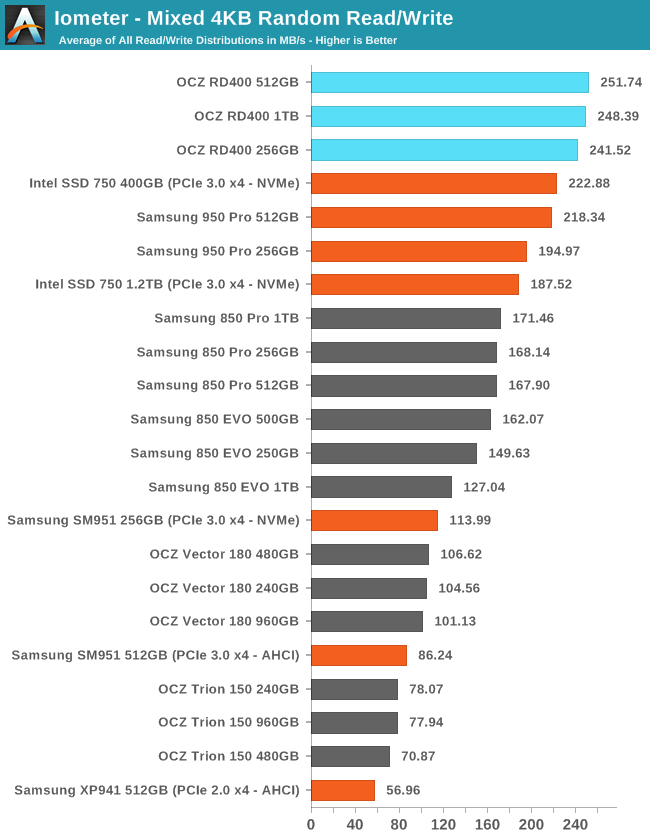
The RD400 sets new records for mixed random I/O performance with a substantial lead over the Intel 750 and Samsung 950 Pro.
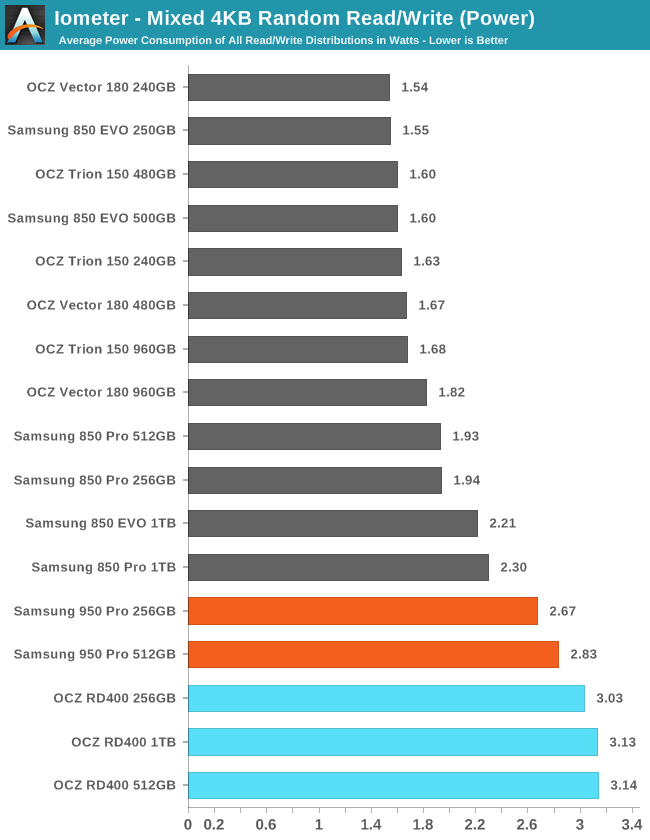
The RD400's power consumption is also record setting, but its efficiency is closer to normal for a PCIe SSD on account of the high power consumption yielding high performance.
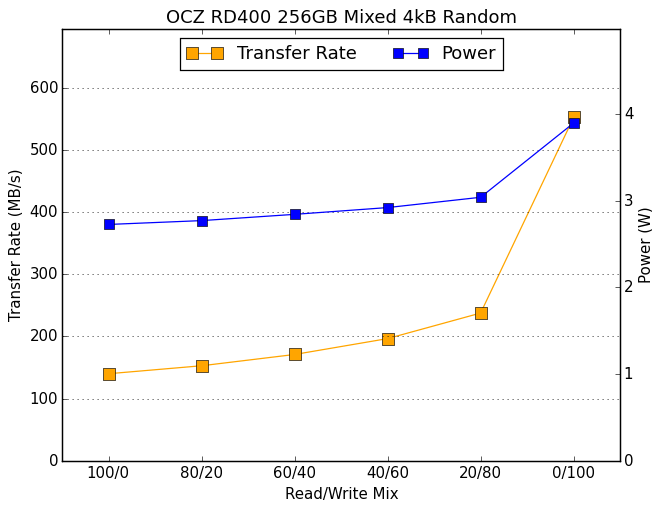 |
|||||||||
Most of the RD400's overall performance advantage is due to strong performance in the final phase of this test where the workload is 100% random writes. The 400GB Intel 750 has even higher random write speed, but performs lower on the other phases of this test.
Mixed Sequential Read/Write Performance
The mixed sequential access test covers the entire span of the drive and uses a queue depth of one. It starts with a pure read test and gradually increases the proportion of writes, finishing with pure writes. Each subtest lasts for 3 minutes, for a total test duration of 18 minutes. The drive is filled before the test starts.
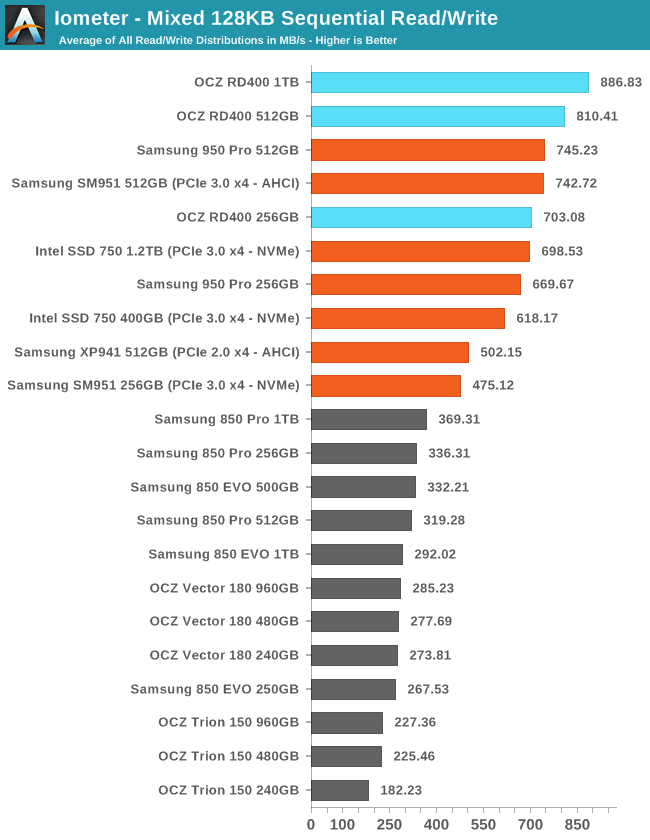
The RD400 handles a mixed sequential workload better than anything else and more than twice as fast as SATA drives.
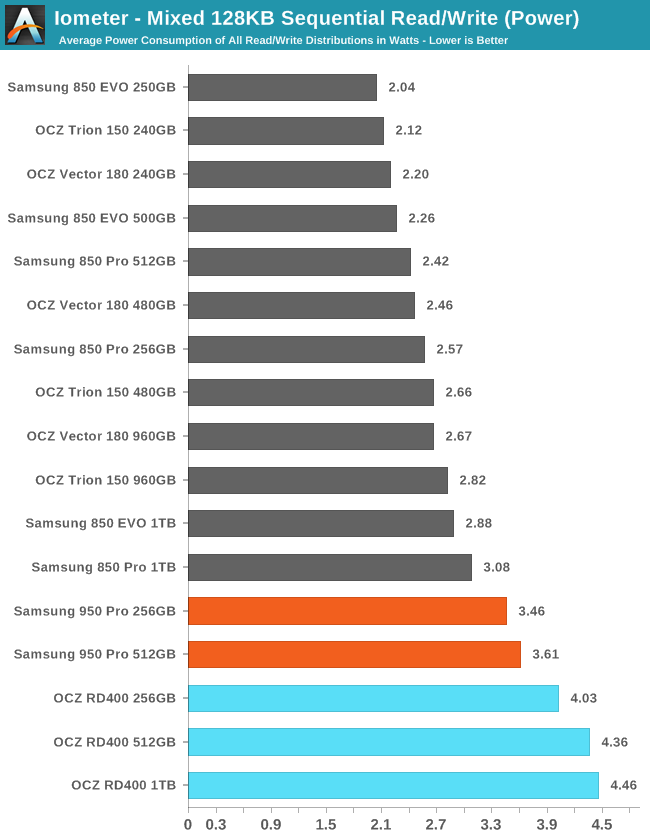
As usual, the RD400 needs plenty of power to deliver its high performance. The Samsung 950 Pro is a bit more efficient despite being slower.
 |
|||||||||
Performance across the mixed sequential test is usually a bathtub curve with the balanced mixes having the lowest performance. The RD400 bottoms out around the theoretical limit for SATA drives, which is substantially better worst-case performance than anything else. The 950 Pro has much better performance during the pure read start of the test but falls behind in the middle of the test and doesn't bounce back as much at the end.










40 Comments
View All Comments
Meteor2 - Thursday, May 26, 2016 - link
So are we saying NVMe is only really useful for enterprise applications? There just aren't consumer use cases where drive speed is now the limiting performance factor?stux - Thursday, May 26, 2016 - link
This might be the case in Windows, but I've found with OSX, one of the biggest upgrades has been sata3 to PCIe ssd gen 1 to 2 and then 3Ien 0.5 to 1 to 2GB/s
This was evident with all the recent MacBook Pro 15" upgrades and also with PCIe ssds in some Mac Pro towers.
SunnyNW - Wednesday, May 25, 2016 - link
Is the flash controller made on the same memory process or is it made on a separate logic process? I think its made on a separate (logic) process and if so would that be 28nm for most controllers? And is the manufacturing out sourced to TSMC or in-house for most?Ryan Smith - Wednesday, May 25, 2016 - link
Controllers are made on a separate logic process.Kristian Vättö - Thursday, May 26, 2016 - link
The PCIe NVMe controllers are mostly 28nm from what I've heard. SATA controllers can be anything from 40nm to +55nm. Like nearly all logic manufacturing, it's outsourced to TSMC and the like.BangkokTech - Friday, May 27, 2016 - link
Recently got the SM950 pro 512. Large writes slow down after 30 seconds. It starts out ETA 3 minutes, 10 minutes later it's only 70% complete. I read into it; evidently these M.2 cards heat up and slow down. There is absolutely no heatsink on the card. Running them on a PCI expansion card would allow headspace for small heatsinks.BangkokTech - Friday, May 27, 2016 - link
Are any of you aware of a ribbon cable/riser cable I could use to get this M.2 card off my motherboard and move it to a cooler part of my case? I'm out of PCI slots for these expansion cards.Billy Tallis - Saturday, May 28, 2016 - link
Even with the degree of thermal throttling I've observed when not using any kind of heatsink, the 512GB Samsung 950 Pro should only take ~12-13 minutes to fill to capacity with sequential writes. I suspect that your bottleneck is whatever is the source of the data being written, not the 950 Pro.BiTesterEmailer - Wednesday, July 20, 2016 - link
Informative and detailed as always.